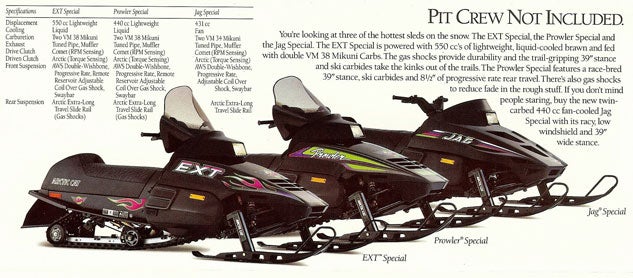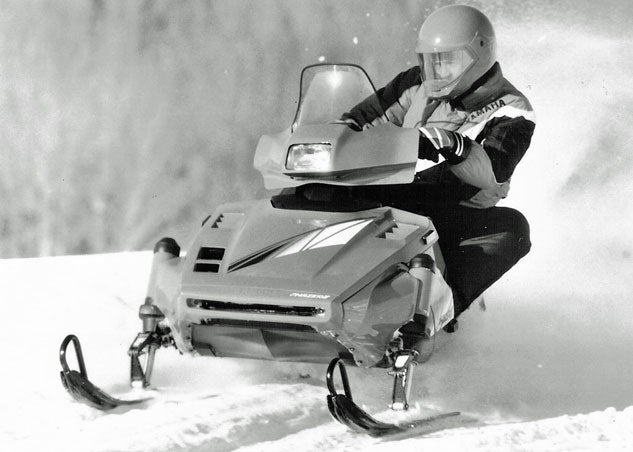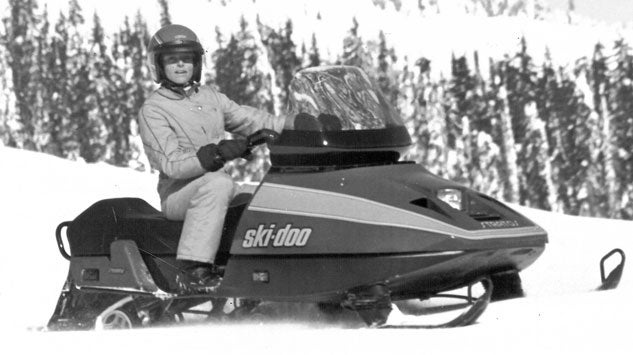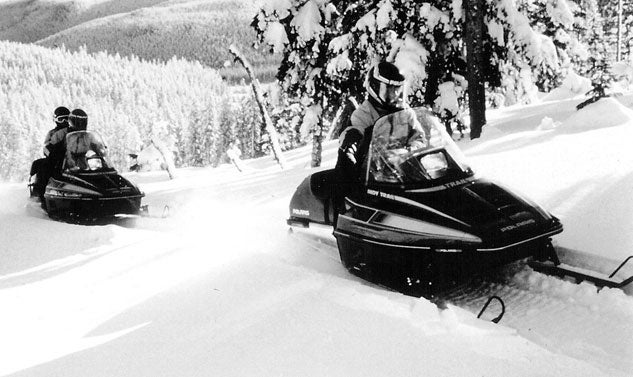1989 Yamaha Phazer II vs. Arctic Cat Prowler

Looking back at a classic confrontation
The black 1965 Mustang notchback rolled down the street, triggering memories as it passed. A smile came to my face, until I noticed the car carried “collector” plates, meaning it was at least 25 years old! Those memories changed from pleasant to “OMG I’m old.” I’d had that identical car back when they were new. Now, who wants to be reminded of how long ago that was?
The same might be said of 25 year-old snowmobiles. According to the International Snowmobile Manufacturers Association, which keeps track of these things, the average 2014 snowmobiler is 44 years old. So, the average snowmobiler was only 19 years of age in 1989. Many likely have fond memories of an early sled that their Dad or grandfather owned back in that day.
Just as we freaked out over a collector edition Mustang, what sleds would have been the popular ones in 1989, a year that even singer Taylor Swift holds dear. As Swift officially breaks from Country music into full-on “pop,” she titled her newest album “1989,” her birth year. Taylor gets, perhaps, a bit carried away when she states that “…I started delving into the late ’80s and what that period of time actually meant… It was, apparently, a time of just limitless potential. … Bright colors, bold chances, rebellion. …The idea of endless possibility…”
 While the 1990 Prowler may have been the first of the all-new Arctco Cats, it would evolve the Arctic Cat brand by 1992.
While the 1990 Prowler may have been the first of the all-new Arctco Cats, it would evolve the Arctic Cat brand by 1992.Well, snowmobilers won’t go that far, but what were the sleds of 1989 like? Were there classics like that 1965 Mustang or were they all beige four-door sedans without personality. Transportation first. Excitement dead last!
COMPARISON: Read our review of the 2014 Yamaha Phazer XTX + Video
Looking back on those 1989 sleds, there were some interesting concepts. Yamaha was a much bigger player in the 1989 snowmobile marketplace than now. The thought of partnering with Arctic Cat would never have happened. The two snowmobile makers were serious head-to-head competitors as Yamaha introduced the second coming of its sales chart busting Phazer. Arctic Cat brought out an all-new sled to the market, the model year 1990 Prowler. It was the first new sled totally developed and marketed by Arctco Inc., the reborn Arctic Cat company that had been selling new sleds based on the designs and technologies of the bankrupt Arctic Cat. The two sleds not only went ski tip to ski tip in the sales arena, but it was Arctic Cat’s tactic to be taken seriously as a sled maker once again. It would work.
 Yamaha’s Phazer II carried Telescopic Strut Suspensions into the 1990s.
Yamaha’s Phazer II carried Telescopic Strut Suspensions into the 1990s.The two sleds may have been built by two different companies, but they struck similar profiles on the snowscapes of North America. Indeed, Yamaha fans of the time referred to the Prowler as the “Copy Cat,” as it mimicked Yamaha’s Phazer, one of the period’s best selling sleds.
Yamaha’s model year 1989 Phazer II carried the original Phazer a step into the future as the company retained the Yamaha fan-cooled engine and the Phazer nameplate, but upgraded virtually everything else. The Phazer II’s 485cc fan-cooled twin put out just under 60 horsepower, with extremely stout midrange. Arctic Cat countered with a Suzuki-built lightweight liquid-cooled 440cc twin developing more than 60 horses. Sled reviews of the time suggested that performance was about equal, with the Yamaha’s torque giving it an edge in the first 100 yards of side-by-side acceleration.
 Do you suppose that “back in the day,” snowmobilers were asking themselves which sleds would be the classics of their day? Probably not!
Do you suppose that “back in the day,” snowmobilers were asking themselves which sleds would be the classics of their day? Probably not!Styling seemed shared as the Cat left little doubt that it was intended to mimic the old Phazer. Cat said that its sled’s target weight was 406-pounds. The Prowler missed that with an official claimed factory weight of 435 lbs. The original Phazer was listed at 399 pounds. The Phazer II came in at a claimed 406 lbs. But, remember that the Phazer was air-cooled and the Cat liquid-cooled.
COMPARISON: Read our review of the 1984 Arctic Cat El Tigre
The two sleds may have looked similar from a styling standpoint – both were wedge-fronted. And the handlebar assembly hid inside a moveable windshield pod that housed the instruments, but where the Phazer carried its headlight on the handlebar pod, the Prowler kept it on the hood and immoveable.
 Head-to-head competition between Cat and Yamaha continued with the clash of the two brand’s top of the line hot rods, the Arctic Cat Wildcat and Yamaha Vmax-4.
Head-to-head competition between Cat and Yamaha continued with the clash of the two brand’s top of the line hot rods, the Arctic Cat Wildcat and Yamaha Vmax-4.Price-wise the two sleds were very serious competitors. The Arctic Cat Prowler listed for US$4,800. The Phazer II started at US$4600 but went up to US$4800 for the electric-start equipped “LE” version.
While they looked similar on the snow, the way they worked through the snow and on the trails was quite different. The Yamaha continued its use of telescopic struts on the front. Arctic Cat’s Prowler countered with an all-new Arctic Front Suspension. It was an evolved double A-arm design that grew from Cat’s racing experience. At 37 inches in width, the Prowler enjoyed a nearly one-inch wider ski stance than Yamaha’s Phazer II. Both sleds featured slide rail suspensions for their 15-inch wide by 121-inch long rubber tracks. But the Prowler gave riders 8.5 inches of travel versus the Phazer II’s six inches.
 Ski-Doo had some classics of the blundering kind back in the late 1980s, such as the Stratos, which would be supplanted by lighter and more nimble models.
Ski-Doo had some classics of the blundering kind back in the late 1980s, such as the Stratos, which would be supplanted by lighter and more nimble models.Yamaha’s Phazer II never had the impact of Arctic Cat’s Prowler, which served as the basis for many seasons of lightweight designs and niches that ran from the original Prowler to a Panther and Pantera two-up and into a series of larger displacement high performance Cats. Introduced in 1989, the two model year 1990 sleds did, indeed, hint of limitless potential, bright colors, bold chances and rebellion, just as Taylor Swift suggested.
COMPARISON: Read our review of the 1986 Yamaha Inviter
But these weren’t the only “classics” of the time. Yamaha tried to prime the market of potential new buyers with its one-up, lightweight, budget-priced motor scooter-derived SnoScoot. That experiment lasted only a few seasons. During this period other brands had their classics as well with Ski-Doo finally starting to get things right after a 1970s product drought. The new sleds hinted strongly at Ski-Doo’s future with new sport performance sleds using strong Rotax engines. And, of course, the Polaris Indy was starting to really catch on as the Indy name became affixed to everything Polaris from Trail models to all-out RXL power triples.
 Twenty-five years ago Polaris’ Indy was on the verge of its decade long reign as the Number One selling snowmobile.
Twenty-five years ago Polaris’ Indy was on the verge of its decade long reign as the Number One selling snowmobile.These were good times overall as the snowmobile industry had hit its low point and sales would trend upwards until the turn of the century, about 2003 when sales peaked from their 1990s highs. But sleds from 25 years ago proved classic as the ski-to-ski competition between Yamaha’s Phazer II and Arctic Cat’s Prowler demonstrated.
| 1989 Arctic Cat Prowler (Pre-production) | 1989 Yamaha Phazer II | |
| Engine | Arctic Cat/Suzuki 440cc, liquid-cooled-cooled, 2-stroke twin; 2xVM34 carburetors | Yamaha 485cc, fan-cooled, 2-stroke twin; 2x B38-32 Mikuni carburetors; reed valve |
| Horsepower | 60-plus (claimed) | 55+ |
| Drive | Comet drive with Arctic driven | Yamaha drive and driven |
| Front Suspension | Arctic A-arm Front Suspension (AFS) with coil-over-shocks; 7.0-in maximum travel | Yamaha telescopic strut suspension (TSS); up to 6-inches of travel |
| Rear Suspension | Arctic Cat parallel rail long travel suspension; adjustable hydraulic shock; 8.5-inches of travel | Yamaha long travel parallel slide rail with up to 6-in travel |
| Length | 108.5 in | 103.5 in |
| Width | 41.5 in | 42.0 in |
| Ski Stance | 37.0 in | 36.2 in |
| Track | 15×121 rubber | 15×121 rubber |
| Weight | 435 (claimed) | 406 (claimed) |
| Fuel Capacity | 7.0+ US Gal | 8.0+ US Gal (87 octane) |
| MSRP | $4,800 | $4,600 to $4,800 (LE) |








 Your Privacy Choices
Your Privacy Choices